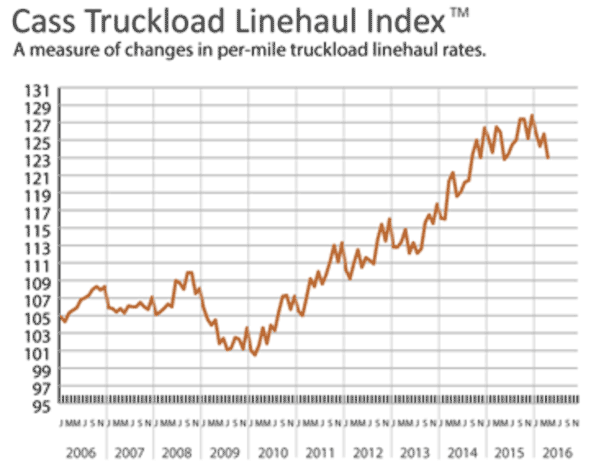It is tough times in the US truckload sector.
American Trucking Associations chief economist Bob Costello recently called the current situation a "freight recession" at the 2016 annual NASSTRAC conference in Orlando.
Supply Chain Digest Says... |
 |
| History largely tells shippers that the industry always seems to adapt to regulations, rate pressures, overzealous brokers, labor shortages, etc. |
 |
What do you say? |
| Click here to send us your comments |
 |
| Click here to see reader feedback |
|
|
The ATA's freight tonnage index decreased 2.1% in April, following a 4.4% drop during March. At a level of 134.8, it is down about 5% from its all-time high of 144 set in February.
Rates have already been decelerating. The Cass Linehaul Index, which measures truckload rates per mile before fuel surcharges, accessorials and other charges, fell 0.6% in March and 2.2% in April, the last month for which data has been released. Increases in January and February were just 0.4% and 0.5% respectively.
John Larkin, who follows the trucking sector for Wall Street Investment firm Stifel, said a recent "road check" he conducted with carriers shows shippers are in the driver's seat in a big way right now.
"Freight rates continue to be under intense pressure," Larkin wrote in a recent research note. "One large dry van carrier told us that 90% of its customers are more or less demanding rate reductions in what continues to be a soft freight environment. Some of these shippers suggest that freight will be lost if rates are not cut 10% or more."
Larkin notes that large 3PLs that source capacity mostly from smaller carriers are leading the rate cutting charge, often submitting very aggressive bids to shippers, evidently confident that they will be able to purchase capacity in the open market over the near term, at least, at even more aggressive price points.
That leaves large, core, asset-based carriers with three choices: they "can match this pricing, walk from the business, or hope that cooler heads will prevail and shippers may accept flat to slightly reduced rates in exchange for maintaining some semblance of a relationship with a core carrier."
But in another note, Larkin says shipper interest in "collaboration" with carriers is at a low water mark.

Source: Cass Information Systems
"Many shippers have effectively elected to toss to the wayside any talk of partnerships, relationships, cooperation, collaboration, etc.," Larkin wrote. "Shippers are under enormous pressure to cut transportation costs and seem not to be satisfied with the massive fuel surcharge reductions racked up over the past year and a half."
(See More Below)
|
CATEGORY SPONSOR: SOFTEON |
|
|
| |
|
|
As usual, it comes down to supply and demand. With the weak freight market, "Capacity remains plentiful even in the face of a driver recruiting and retention world that remains challenging, at best," Larkin adds.
Will Approach Cause Problems for Shipper in the End?
 Shippers, for the most part, appear to be shrugging off any near term possibility of a capacity shortage, Larkin notes. While they have heard that the "mother of all capacity shortages" is coming at some point down the road, "the currently very loose supply-demand dynamic seems to confound the capacity crunch thesis, which has hung around a little too long with little hard evidence surfacing so far." Shippers, for the most part, appear to be shrugging off any near term possibility of a capacity shortage, Larkin notes. While they have heard that the "mother of all capacity shortages" is coming at some point down the road, "the currently very loose supply-demand dynamic seems to confound the capacity crunch thesis, which has hung around a little too long with little hard evidence surfacing so far."
History largely tells shippers that the industry always seems to adapt to regulations, rate pressures, overzealous brokers, labor shortages, etc., Larkin says, without the predicted major impact on rates.
Shippers "will happily deal with the capacity crisis, when, and if, it ever materializes," he adds.
However, Larkin says he has concluded that spot rates have been pushed down so aggressively by 3PLs/brokers that many small carriers, often reliant on 3PLs for some or all of their freight, may not make it to the end of 2017 when electronic logging devices are, under the present rule, going to have to be installed in all trucks engaged in interstate commerce.
"Industry pricing, especially in the spot market, is so weak that many carriers, even non-compliant carriers, may not survive until the end of 2017," Larkin writes. If accurate, that of course could lead to major issues with capacity, combining a loss of carriers with the effective reduction of capacity that will come with deployment of the data loggers, which will prevent driver "cheating" on miles driven.
While "The short term outlook has weakened, the long term outlook has become more bullish" in terms of carriers and rates, Larkin concludes.
Your Comments/Feedback
|